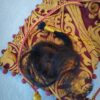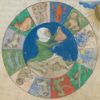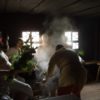Blog
All posts from the category "Hygiene and cosmetics".
You may know my Bathhat from a couple of years ago. Please refer to this one for some of the basics, some of the sources and techniques.
Since I got a little better making hats over time, I wanted to give it another try and I am much happier with the form and fit. (more…)
Today, I would like to talk to you about a special substance in medieval material substance, human hair. (more…)
Today we are talking about menstrual hygiene in medieval times!
Today we would like to show you some sources and techniques for doing laundry in the 14th and 15th century.
Short and sweet this time: I made a new hair ribbon, inspired by an extant ribbon from the London finds from the first half oft he 14th century.
The original, Nr. 451 was pink and yellow striped, made from silk and woven with 12 tablets, which (as far as I could see from the quite bad quality black and white photos in „Clothing and textiles) were Z-directed on the left half and S-directed in the right half of the ribbon.
I exchanged the colours into indigo dyed blue and reseda dyed yellow and worked with only 10 tablets that I directed in S and Z interchangingly.
This was a little training for me since I want to do one or two more difficult tablet weaving projects in the future.
The silk I bought – as always – from Marled Mader.
I would like to give a special shoutout here to Silvia Ungerechts. I am only a tablet weaving noob that does the craft only because I sometimes need a tablet woven ribbon for another project. But she is a constant inspiration and help to me that I really look up to
At the beginning of last October, I was part of the 14th century team at Medieval days at the open air museum Bad Windsheim, Germany. My colleague Thomas (who played the barber/bathhouse owner) and me (as the bathing maid) were assigned to lead the bathhouse belonging to a late medieval hospital in Bad Windsheim, that was the main topic of this event for us.
As a guest of dear interpreter friends from southern Germany, I was part of the Mittelaltertage im Freilandmuseum Bad Windsheim event during which several interpreters from early and late medieval period are living in the houses of the open air museum for several days.
Since the local hospital celebrated it’s 700 year anniversary, there was a wonderful special exhibition in the nearby Museum Kirche in Franken on the topic of medieval and post medieval hospitals which two of the leading interpreters of our part of the event were involved in creating.
This anniversary was our inspiration for the 14th century part of the event. In 3 different houses we recreated different parts of the hospital business and showed different aspects of care for the sick and the administration of the hospital. A detailed report of the event will follow soon.
Each of the 20 interpreters involved had a certain topic or area to prepare and me and Thomas, my IG14 colleague chose to manage the bathhouse integrated in the hospital due to our previous experiences in that topic . For this I still needed some equipment.
On one of our events at the Museum Tiroler Bauernhöfe last weekend, I did a little lecture on hair care and hair dos as well as hair in general. I brought this to digital paper now to be able to link it in the future.
Please do follow also the links in the text to find further reading material, original sources and intersting tutorials.
When you imagine a medieval man or woman, what do you see? Foul teeth? Greasy hair? Dirty, bumpy skin? Hairy armpits and sweat stench?
Well, for some of them, this might have been true. For some people today, this is still true. But medieval sources prove, that it could be and has been different for large parts of the population. Medieval people know far more than we think today.
In this article I want to talk about aspects of (female) beauty routine and cosmetics, as we find them in medieval sources (mainly the Trotula).


















